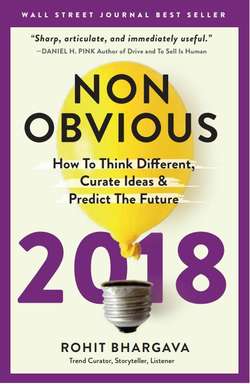Читать книгу Non-Obvious 2018 Edition - Рохит Бхаргава - Страница 74
На сайте Литреса книга снята с продажи.
Оглавление4
TRUTHING
What’s the Trend?
As a consequence of eroding trust in media and institutions, people are engaging in a personal quest for the truth based on direct observation and face-to-face interaction.
I remember once browsing the Internet I encountered a headline that seemed too ridiculous to be true: “Harry Potter Books Spark Rise In Satanism Among Children.” Indeed it turned out to be a joke – and it was one of the first times that I read The Onion, a comedy news site that takes modern stories and creates intentionally hilarious twists on them designed to entertain. At the time that story was quickly uncovered to be a work of satire. Today the line between truth, lies, satire and fiction has become much harder to distinguish.
The truth has a media problem.
The term fake news, which had no meaning two years ago, has become one of the most popular accusations traded back and forth between politicians and media personalities alike. We are surrounded by routine sensationalism peddled by 24-hour news channels desperate to invent a perpetual stream of “breaking news.” Lost in the midst of all this televised finger wagging is a shared sense of reality. Thankfully, that hasn’t stopped one underappreciated group of truth seekers.
On July 5, 2017, a dedicated group of 190 top fact-checkers from 54 countries attended the Poynter Institute’s fourth annual Global Fact-Checking Summit (Global Fact). Their mission never felt more urgent. In the time since they had last met, Donald Trump had taken office, fake news had become an everyday term, and casual indifference toward the truth seemed to be growing.
Only a month earlier, a widely shared study found that around 59 percent of links shared on social media had never been clicked, including links that went viral and were shared thousands of times.1
The conclusion: People were actively sharing stories based on headlines alone, without reading the article. But even a headline can mislead a large group of people, sparking a growing need for objective ways to confirm the accuracy of the news we read.
“Forget clickbait.
We’re living in the age of sharebait now.”
Caitlin Dewey, Washington Post
At Global Fact, participants celebrated the international growth of fact-checking as a discipline. The participating organizations were impressive and spanned the globe. Faktisk, for example, is an independent group founded by journalists from four competing Norwegian media organizations. La Silla Vacía is a Colombian news site that uses the messaging app WhatsApp to distribute fact-checked media and track false content or stories. Julien Pain, the editor-in-chief of France 24’s program Observateurs, started an online live streaming program called Instant Détox to talk to people about media, misinformation, and rumors on the street. The goal is to debunk them in real time and to provide unbiased, transparent corrections.
This global quest for truth through fact-checking and on-demand transparency is also attracting some wealthy sponsors. Philanthropic investment firm the Omidyar Network announced that it would donate $100 million to support investigative journalism, fight misinformation, and take on hate speech. In one of his first projects since leaving Microsoft, former CEO Steve Ballmer led the creation of USAFacts.org, a comprehensive database of facts that is designed to offer more transparency regarding how the US government spends its money.
All of these organizations are responding, in various ways, to the reality of a world in which people are forced to doubt everything they see on social and mainstream media, hear from companies, politicians, and are told by their own social connections. The defining question of media today has become who can you believe?
Considering this context, the average person looks around and decides that the only trustworthy person is themself. This makes things even worse. As more of us look inward for our own definitions of the truth, the result is a trend we call Truthing, when the personal quest for facts leads each of us (for better and worse) to rely on direct observation, personal experience, face-to-face-interactions, and the opinions of those who look, talk, and think like we do.
Reengineered Media Diets and the Rise of Curators
Some of these seemingly trustworthy opinions come from intellectually superior cable news hosts who specialize in delivering a steady stream of sound bites taken severed from their context, and outrage-inducing monologues (see Chapter 10 on Manipulated Outrage). In response, people are turning to more approachable curators of news to help explain the world in a more human voice—like a slightly opinionated but non-judgmental big sibling who is always in-the-know.
The continued popularity of curated daily email newsletter theSkimm is a perfect example of this. theSkimm essentially offers “all the news you need to start your day,” and founders, former TV news producers Danielle Weisberg and Carly Zakin, strike a conversational tone that invites trust from their readers, many of whom are female Millennials as well. This large audience feels comfortable relying on them for their news, and in a little over five years, their newsletter has attracted more than 5 million subscribers.
